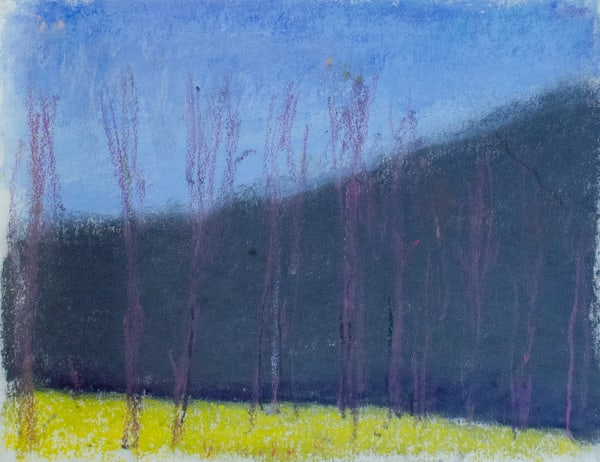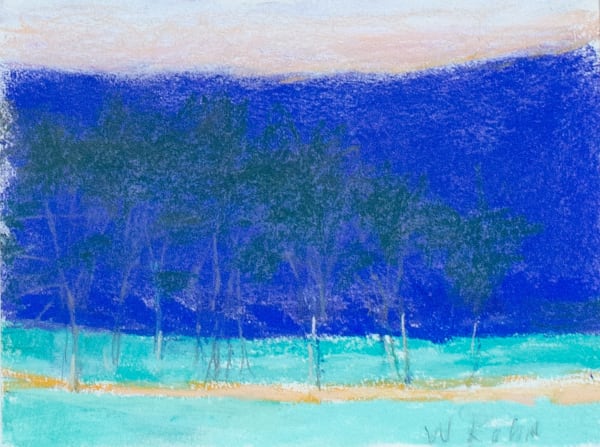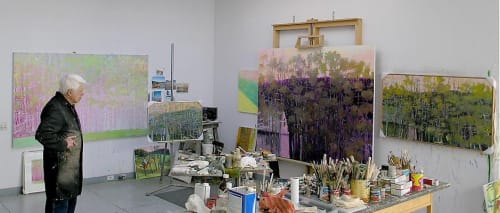-
 Off Route #5, Guilford, Vermont, 1975
Off Route #5, Guilford, Vermont, 1975 -
 Summer Studio, 2012
Summer Studio, 2012 -
 Strong Pink, 2000
Strong Pink, 2000 -
 Dark Diagonal, 2012
Dark Diagonal, 2012 -
 Barns and Silos in New Jersey, 1985
Barns and Silos in New Jersey, 1985 -
 Behind Reeds, 2004
Behind Reeds, 2004 -
 Purple Hills
Purple Hills -
 Blue Hills in the Green Mountains, 1981
Blue Hills in the Green Mountains, 1981 -
 MacArthur House in Marlboro, Vermont, 1999
MacArthur House in Marlboro, Vermont, 1999 -
 On the Brow of a Hill, 1992
On the Brow of a Hill, 1992 -
 Predominantly Blue, 1997
Predominantly Blue, 1997 -
 Valley Pond, 1996
Valley Pond, 1996
An important member of the second generation New York School, Wolf Kahn is renowned for his luminous, richly colored landscapes. Focusing on such thematic imagery as the tended fields, houses and sturdy barns of New England, Kahn's work represents a masterful synthesis of illusionistic representation and abstraction.
Kahn was born in Stuttgart, Germany, in 1927. As a boy, he studied painting and drawing in Frankfurt. In 1939 his family separated by the Nazi upheaval, Kahn was sent to Cambridge, England, with other refugee children. One year later he arrived in New York City, where he was united with his father, a noted musician. Kahn continued his education at the New York High School of Music and Art, graduating in 1945. During 1946 after a brief period of service in the Navy, he worked under Stuart Davis at the New School for Social Research. From 1947 until 1949, Kahn attended Hans Hofmann's School of Fine Art in New York. He also spent a summer as Hofmann's studio assistant in Provincetown.
In 1950 Kahn enrolled at the University of Chicago, receiving his bachelor's degree a year later. After a period of traveling across the continent and working in Oregon as a lumberjack, he returned to New York and resumed painting. In 1956, along with several other of Hofmann's former students, he helped found the Hansa Gallery, one of the first artists' co-operative loft galleries. During these years, Kahn was one of several young artists, including Elaine de Kooning and Robert De Niro, who were influenced by action painting but, at the same time, felt the need to reintroduce nature back into their art.
Kahn's early work consists of still lifes and figure studies, which show the influence of Hofmann's "push-pull" space as well as his gestural energy. However, Kahn's mature style revolves around the portrayal of un-peopled landscapes in which he combined an expressive chromaticism (inspired by Milton Avery and Mark Rothko) with an emphasis on the dynamics of light and atmosphere. Many describe him as a Luminist, carrying on the 19th century tradition but with a thoroughly modern sensibility. Kahn drew much of his subject matter from the landscape in and around his farm in Vermont, where he spent his summers.
Kahn had numerous solo exhibitions, organized by such institutions as the San Diego Museum of Art (1984, 1987), the Munson-Williams-Proctor Institute (1882), the Arts Club of Chicago (1981) and the Rhode Island School of Design Museum (1979). He was also the recipient of many awards and prized, including a Guggenheim Fellowship (1966-67).












